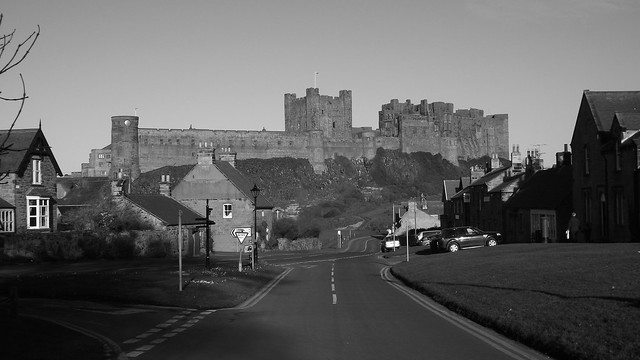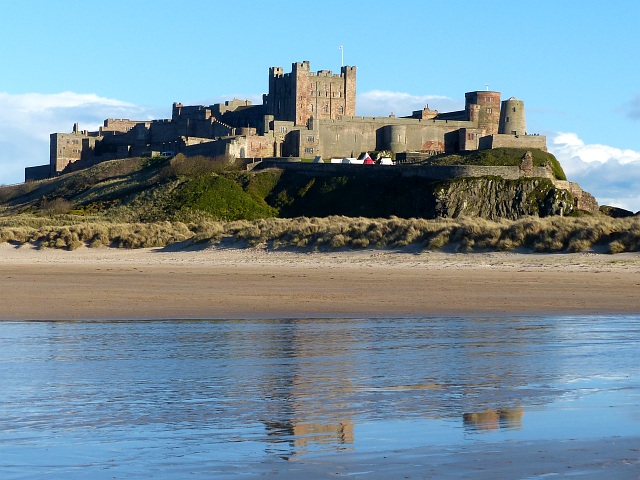Topics > Northumberland > Bamburgh > Bamburgh Castle > Bambrugh Castle Township, 1848
Bambrugh Castle Township, 1848
BAMBROUGH-CASTLE, a township, in the parish, and N. division of the ward, of Bambrough, union of Belford, N. division of Northumberland, 5 miles (E. by N.) from Belford; containing 59 inhabitants. This township is principally distinguished for its castle, built about the middle of the sixth century, by Ida, the first Anglo-Saxon king of Northumbria. In 642 it was besieged by Penda, King of Mercia, who, after an unsuccessful attempt to set it on fire, was compelled to retreat. In the beginning of the eighth century, Berthfrid, guardian of Osred, the young Northumbrian king, defended it against the usurper Eadulph, who was taken prisoner and put to death. It was plundered and almost demolished by the Danes in 993, but was soon restored. After the Norman Conquest it was held by Robert de Mowbray, on whose insurrection against William Rufus it was besieged, and, after an obstinate defence, surrendered to that monarch, who threatened, unless it were given up, to put out the eyes of Mowbray, who had been taken prisoner. During the war between Stephen and the Empress Matilda, and the protracted struggle between the houses of York and Lancaster, the castle sustained repeated sieges: it was taken in 1463 by Margaret of Anjou, queen of Henry VI., on her route to Hexham, after landing at Berwick, on her return from France, and at length became dilapidated in the reign of Henry VII. The castle and manor were granted in the reign of James II. to John Forster, one of whose descendants having joined the Pretender, they were confiscated to the crown, and were purchased by Lord Crewe, Bishop of Durham, who, in 1720, devised to trustees his manors of Bambrough and Blanchland, then producing £1312 and now £8126 per annum, for charitable purposes. The income is appropriated to the erection and repair of churches, the support of exhibitions and fellowships, the relief of the poor, the foundation and endowment of schools, the maintenance of the establishment at Bambrough Castle, the improvement of Sunderland harbour (for which £5000 have been paid out of the funds), and various improvements along the coast. Under the direction of Dr. Sharp, Archdeacon of Durham, the castle was repaired in 1757, the keep being set apart for the occasional residence of the trustees; and the whole is maintained in repair, with its furniture, by an estate left by Dr. Sharp for the purpose.
The castle is situated on the summit of a steep rock, which projects into the sea and rises perpendicularly to the height of 150 feet above low-water mark, being accessible only on the south-east side, where is the ancient gateway flanked with a circular tower on each side, and formerly defended by a trench cut through a narrow isthmus communicating with the main land. Within a short distance of this is a more modern gateway, with a portcullis; and a little further on is a round tower. The keep, which is of Norman architecture, and the most ancient part of the building, is a lofty square structure. In 1773, the ruins of a church or chapel, erected in the castle during the Norman period, were discovered; and the font, richly carved, is preserved, among other curiosities, in the keep. In the castle-yard are granaries, in which corn is stored to be sold to the poor at proper times; and a market is opened every Tuesday and Friday, when the industrious poor are supplied with meal and grocery at the cost price. In another part of the castle-yard is a dispensary, at which a surgeon attends twice every week; and from the surplus revenue the trustees have established two national schools, for which schoolrooms have been appropriated in the castle, and which are free to all poor children who may come. Thirty girls, between the ages of nine and sixteen, are admitted to board and lodge, and are likewise provided with clothes and washing. In 1778, the trustees founded a library, to which Dr. Sharp generously bequeathed the whole of his valuable books, including the greater part of the library of Dr. Sharp, Archbishop of York; and this collection, including nearly 6000 volumes, is open to persons residing in the neighbourhood, under certain regulations. A principal object of the establishment is also to afford assistance to shipwrecked mariners.
Extract from: A Topographical Dictionary of England comprising the several counties, cities, boroughs, corporate and market towns, parishes, and townships..... 7th Edition, by Samuel Lewis, London, 1848.





